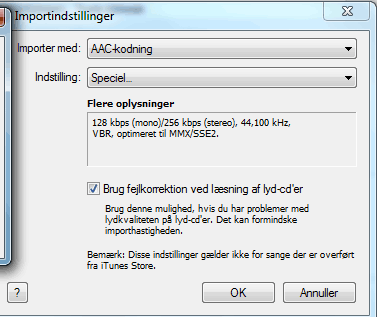Audio Encoding
Updated: 2011-11-07 18:05:04
 This was a very good test. You, sir, picked a very good song for this test (in the sense that it’s very hard to tell the difference). It took me several listenings to pick out the correct one (which i did manage).
Now i want to point out a few things here.
First of all, you didn’t specify how the encoding was done and with which encoder. You see, 128 kbit MP3′s are typically ALWAYS encoded in Joint Stereo by most modern encoders, while 320 kbit MP3′s can often vary between normal ...
This was a very good test. You, sir, picked a very good song for this test (in the sense that it’s very hard to tell the difference). It took me several listenings to pick out the correct one (which i did manage).
Now i want to point out a few things here.
First of all, you didn’t specify how the encoding was done and with which encoder. You see, 128 kbit MP3′s are typically ALWAYS encoded in Joint Stereo by most modern encoders, while 320 kbit MP3′s can often vary between normal ...
 Mike Matthews interviewed by Vintage Guitar Posted 11 4 2011 Tweet EHX’s , Mike Matthews , was the subject of an in depth interview in the December 2011 issue of Vintage Guitar magazine . Read what Vintage Guitar has to say about Mike Matthews , The Special Effect at Electro-Harmonix Click here to read the interview Subscribe to EHX via : Facebook YouTube MySpace Twitter RSS The EHX Community Here are a few easy ways to stay informed on the latest news from Electro-Harmonix . Forums Discussion Support Have a question , comment , suggestion Come join the EHX Forums You'll meet EHX staff and knowledgable users from around the . world Visit the EHX Forums EHX Merch Shop Show your colors with an EHX t-shirt you can even custom design your own shirt from scratch Visit the EHX Merch Shop EHX
Mike Matthews interviewed by Vintage Guitar Posted 11 4 2011 Tweet EHX’s , Mike Matthews , was the subject of an in depth interview in the December 2011 issue of Vintage Guitar magazine . Read what Vintage Guitar has to say about Mike Matthews , The Special Effect at Electro-Harmonix Click here to read the interview Subscribe to EHX via : Facebook YouTube MySpace Twitter RSS The EHX Community Here are a few easy ways to stay informed on the latest news from Electro-Harmonix . Forums Discussion Support Have a question , comment , suggestion Come join the EHX Forums You'll meet EHX staff and knowledgable users from around the . world Visit the EHX Forums EHX Merch Shop Show your colors with an EHX t-shirt you can even custom design your own shirt from scratch Visit the EHX Merch Shop EHX A year and a half ago, I bought Clutch’s Blast Tyrant album on CD. Immediately, something seemed…off. I am still new to the audio nerd scene, and was newer then, and I could not place the weirdness.
Later, I read a couple articles in Guitar World about recording music – especially hard rock and metal – and the author discussed mixing and mastering. Also, in reading up on the loudness wars, I became more and more attuned to the concept of over-compression. As I listened to Blast Tyrant more, it seemed ...
A year and a half ago, I bought Clutch’s Blast Tyrant album on CD. Immediately, something seemed…off. I am still new to the audio nerd scene, and was newer then, and I could not place the weirdness.
Later, I read a couple articles in Guitar World about recording music – especially hard rock and metal – and the author discussed mixing and mastering. Also, in reading up on the loudness wars, I became more and more attuned to the concept of over-compression. As I listened to Blast Tyrant more, it seemed ... I used to think that audio files were basically a collection of snapshots of a spectrum analyzer with various frequencies at various levels. Then I realized, That isn’t how audio works!
On any given track, all the various frequencies superimpose to have a single oscillating voltage. Think about it: if you have only two frequencies – a very low bass and a high-mid, for example – the speaker will be movinng roughly slowly, but if you zoom in, it is oscillating to the frequency of the higher frequency even as the ...
I used to think that audio files were basically a collection of snapshots of a spectrum analyzer with various frequencies at various levels. Then I realized, That isn’t how audio works!
On any given track, all the various frequencies superimpose to have a single oscillating voltage. Think about it: if you have only two frequencies – a very low bass and a high-mid, for example – the speaker will be movinng roughly slowly, but if you zoom in, it is oscillating to the frequency of the higher frequency even as the ...